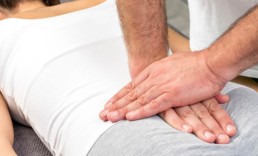The technical term for the tailbone is coccyx, which is derived from the Greek word for cuckoo. It was so named because the bone resembles the shape of the cuckoo bird’s beak. Now that we have that settled, let’s discuss tailbone pain itself. It is also known, technically, as coccydynia.
What causes Tailbone Pain?
Coccydynia is an injury to the tailbone, which is a multi-segmented bone that sits at the base of the spine immediately above the buttocks. The tailbone is small, but mighty. It helps to stabilize you when you sit and it is located in an area of the body full of tendons, muscles and ligaments.
Generally, tailbone pain sufferers experience dull, throbbing pain at the base of the spine reminiscent of a muscle spasm, but they may also feel sharp, stabbing pain when sitting for long periods of time or after being active. The pain may radiate up your back or down your legs and it may feel as if the injury is located in your tailbone itself or in the surrounding area. Sex and defecation may become painful, and women may also feel discomfort during menstruation.
Tailbone injuries have a variety of causes. A direct blow to the area that may be caused by a fall from your bicycle, for example, can result in coccydynia. Pregnancy and childbirth are also potential causes; in your last trimester of pregnancy, the ligaments in the area loosen to provide the baby with space, while a natural birth can cause trauma to the tailbone.
If you sit for long periods of time, especially if your sitting position is an awkward one or you are sitting on a hard surface like a bench, tailbone injury can result. Other potential causes include a weak pelvic floor, joint degeneration and straining due to hemorrhoids or constipation.
Tailbone Pain Treatment
Generally, coccydynia will disappear by itself in a few weeks or months. However, there’s no need to suffer unduly before the pain dissipates.
You can use over-the-counter non-steroidal anti-inflammatory medication to lessen the inflammation that is causing pain; acetaminophen, ibuprofen, naproxen or COX-2 inhibitors are helpful.
How can I relieve my Tailbone Pain?
You can ice the area immediately after the pain begins and do so for a couple of days to reduce inflammation. However, after the first few days, heat will be more helpful. Heat applied directly to the area with adhesive heat strips, a heating pad or a hot water bottle can relieve the muscle tension that causes or exacerbates the pain.
If the pain worsens during bowel movements or due to constipation, your dietary habits may require some changes. You’ll want to increase your intake of both fibre and water and you may want to consider using a stool softener.
If you are required to sit for long periods of time, a donut cushion can help relieve some of the pressure to the area; consider using one at home, at work and in the car. Whether you use one or not, make a conscious effort not to sit for long stretches of time; get up and walk around at least once an hour or consider switching to a standing desk.
Poor posture aggravates the pressure on the tailbone, so be sure to sit with your feet flat on the floor and your back against the back of the chair. When you sit down, lean forward.

Tailbone Pain Exercises and Stretches
A physiotherapist can also demonstrate ways to help reduce your pain and prescribe a suitable course of exercises that will alleviate tension and strengthen the surrounding muscles, including the stomach and the pelvic floor.
Once movement is less painful, your physiotherapist may recommend gentle aerobic activity to increase the blood flow to the area to promote healing. Aerobic exercise also stimulates the release of endorphins, which are your body’s natural pain-relieving chemicals.
A physician may suggest gentle massage to the muscles attached to the tailbone. He or she might also inject a local anesthetic into the tailbone to relieve pain for a few weeks.
Surgery to remove the tailbone is a last resort and won’t be suggested until all other avenues of treatment are exhausted.
If you have severe, unrelenting pain that persists, you shouldn’t ignore it; there may be a more serious underlying cause. Your physician will want to conduct diagnostic tests, such as X-rays or an MRI, to determine if tumours, cysts or bone spurs are causing the coccydynia.
Remember, it’s the tail that wags the dog, so to speak. If your tailbone hurts, you’ll feel like growling instead, so get treatment.
